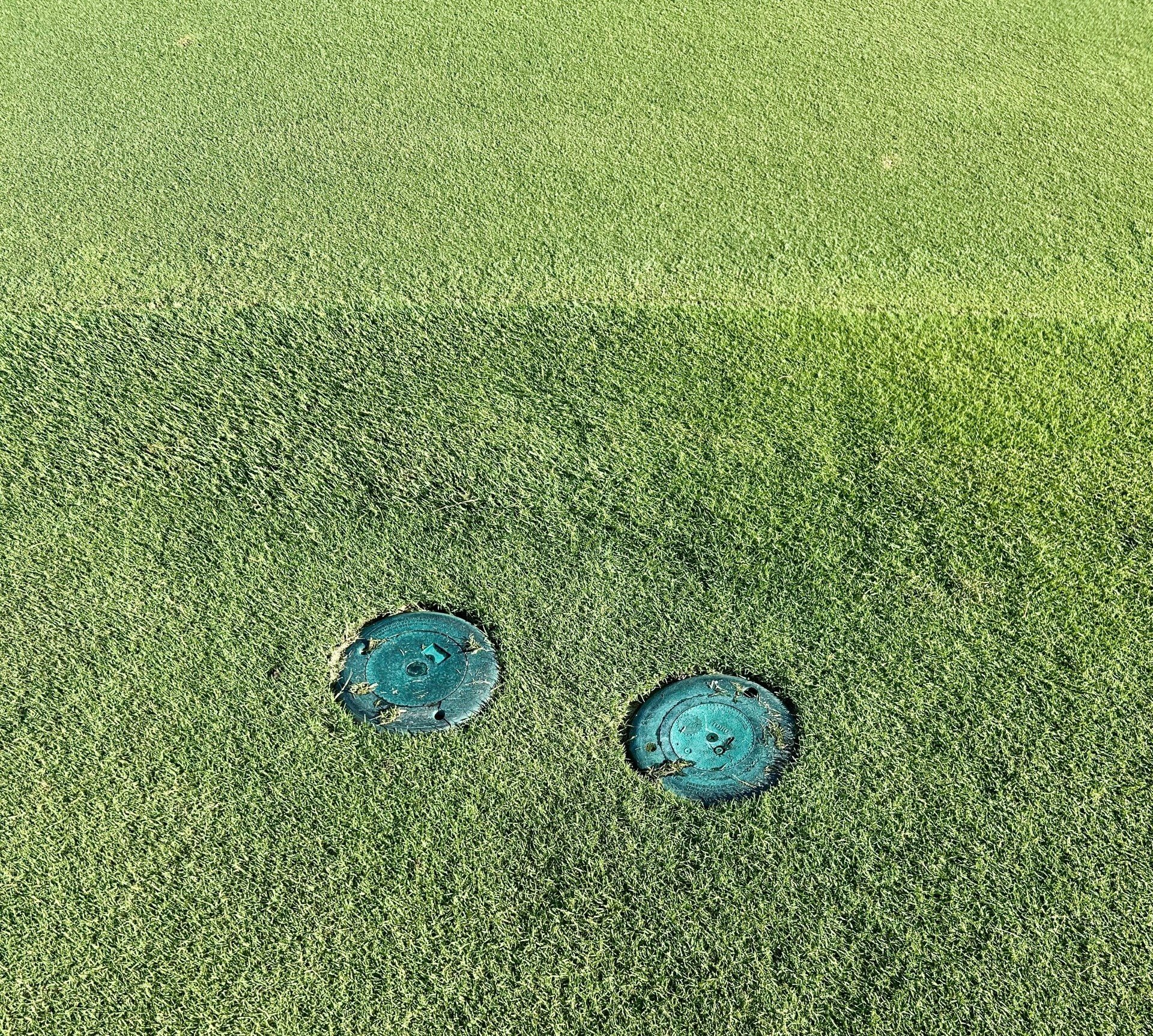Rules Topic – Hard Card IMMOVABLE OBSTRUCTIONS CLOSE TO THE PUTTING GREEN

To begin learning the Rules of Golf, it is recommended to start by thoroughly reading and studying the definitions provided in the Rules of Golf book. Gaining an understanding of the “Language of the Game” and the specific meanings of common words used in the rules, such as “immoveable obstruction,” “moveable obstructions,” “relief area,” “club-length,” and “line of play,” is crucial.
Often, during your competition rounds situations arise that are a little more complicated to navigate without applying multiple definitions and if not multiple rules of golf, Local Rules and PBCGA Hard Card to get an answer on how to proceed. For example, encountering sprinkler heads (immovable obstructions) around putting greens is a common occurrence in Florida.
New in 2025, the Palm Beach Golf Association has added Model Local Rule F-5.1 Immovable Obstructions Close to Putting Greens to it’s HARD CARD for all PBCGA Competitions.
IMMOVABLE OBSTRUCTIONS CLOSE TO THE PUTTING GREEN:
Model Local Rule F-5.2 is in effect. For a ball in the general area, relief may be taken under Rule 16.1b when both the ball and obstruction lie in an area cut to fairway height or less. The obstruction must be located (a) On or within two club-lengths of the putting green, (b) On the player’s line of play, and (c) The ball must be within two club-lengths of the obstruction. The player may take relief as follows: The ball must be lifted and dropped at the nearest point to where the ball lay that (a) is not nearer the hole, (b) avoids intervention and (c) is not in a penalty area or on a putting green. The ball may be cleaned when lifted.
F-5 Immovable Obstructions Close to Putting Greens
Purpose. When a ball lies anywhere other than on the putting green, an immovable obstruction on the player’s line of play is not, of itself, interference under Rule 16.1. Free relief is normally not allowed.
But if the aprons or fringes of putting greens are cut short enough that putting from off the green is likely to be a common choice of stroke, immovable obstructions that are close to the putting green may interfere with such strokes.
In that case, the Committee can choose to give an extra relief option under Rule 16.1 when a player’s ball lies in the general area and an immovable obstruction close to the putting green is on the player’s line of play.
The Committee may limit such relief to certain situations, such as only for particular holes or obstructions, or only when the ball and the obstruction are in part of the general area cut to fairway height or less.
Model Local Rule F-5.1
“Relief from interference by an immovable obstruction may be taken under Rule 16.1.
The player has an extra option to take relief when such immovable obstructions are on or close to the putting green and on the line of play:
Ball in General Area. The player may take relief under Rule 16.1b if an immovable obstruction is:
-
On the line of play, and is:
- On or within two club-lengths of the putting green, and
- Within two club-lengths of the ball.
Exception – No Relief If Line of Play Clearly Unreasonable. There is no relief under this Local Rule if the player chooses a line of play that is clearly unreasonable.
Penalty for Playing Ball from a Wrong Place in Breach of Local Rule: General Penalty Under Rule 14.7a.”
Model Local Rule F-5.2
Model Local Rule F-5.1 applies but with the following addition to the second paragraph:
"This Local Rule only applies when both the ball and the obstruction are in part of the general area cut to fairway height or less."
Definitions to Remember:
Immovable Obstruction
Any obstruction that cannot be moved without unreasonable effort or without damaging the obstruction or the course, and otherwise does not meet the definition of a movable obstruction.
Movable Obstruction
An obstruction that can be moved with reasonable effort and without damaging the obstruction or the course.
If part of an immovable obstruction or integral object (such as a gate or door or part of an attached cable) meets these two standards, that part is treated as a movable obstruction. But this does not apply if the movable part of an immovable obstruction or integral object is not meant to be moved (such as a loose stone that is part of a stone wall).
Relief Area
The area where you must drop a ball when taking relief under a Rule. Each relief Rule requires you to use a specific relief area whose size and location are based on these three factors:
- Reference Point: The point from which the size of relief area is measured.
- Size of Relief Area Measured from Reference Point: The relief area is either one or two club-lengths from the reference point, but with certain limits:
-
Limits on Location of Relief Area: The location of the relief area may be limited in one or more ways so that, for example:
- It is only in certain defined areas of the course, such as only in the general area, or not in a bunker or a penalty area,
- It is not nearer the hole than your reference point or must be outside a penalty area or a bunker from which you are taking relief, or
- It is where there is no interference (as defined in the particular Rule) from the condition from which you are taking relief.
Nearest Point of Complete Relief
Your reference point for taking free relief from an abnormal course condition (Rule 16.1), dangerous animal condition (Rule 16.2), wrong green (Rule 13.1f) or no play zone (Rules 16.1f and 17.1e), or in taking relief under certain Local Rules.
It is the estimated point where your ball would lie that is:
Nearest to your ball’s original spot, but not nearer the hole than that spot,
In the required area of the course, and
Where the condition does not interfere with the stroke you would have made from the original spot if the condition was not there.
Estimating this reference point requires you to identify the choice of club, stance, swing and line of play you would have used for that stroke.
Club-Length
The length of the longest club of the 14 (or fewer) clubs you have during the round (as allowed by Rule 4.1b(1)), other than a putter. For example, if the longest club (other than a putter) you have during a round is a 43-inch (109.22 cm) driver, a club-length is 43 inches for you for that round.
Line of Play
The line where you intend your ball to go after a stroke, including the area on your line that is a reasonable distance up above the ground and on either side of your line.
The line of play is not necessarily a straight line between two points (for example, it may be a curved line based on where you intend the ball to go).
By thoroughly understanding the definitions of important terms, golfers can navigate the Rules of Golf more effectively and make well-informed decisions while on the course.
For full information and a collection of resources about changes to the Rules of Golf for 2023, visit https://www.usga.org/rules/rules-and-clarifications/rules-and-clarifications.html
For the full library of telecasts and films from golf’s iconic moments, get the FREE USGA OnDemand app for your Connected TV or mobile device. Available on Apple TV, Roku, Amazon Fire TV, Android TV, iOS, Android, and XBox. Check it out here: https://www.usgaondemand.com.
The USGA is a nonprofit organization that celebrates, serves and advances the game of golf. Founded in 1894, we conduct many of golf’s premier professional and amateur championships, including the U.S. Open and U.S. Women’s Open. With The R&A, we govern the sport via a global set of playing, equipment, handicapping and amateur status rules. The USGA campus in Liberty Corner, New Jersey, is home to the Association’s Research and Test Center, where science and innovation are fueling a healthy and sustainable game for the future. The campus is also home to the USGA Golf Museum, where we honor the game by curating the world’s most comprehensive archive of golf artifacts. To learn more, visit https://www.usga.org.

